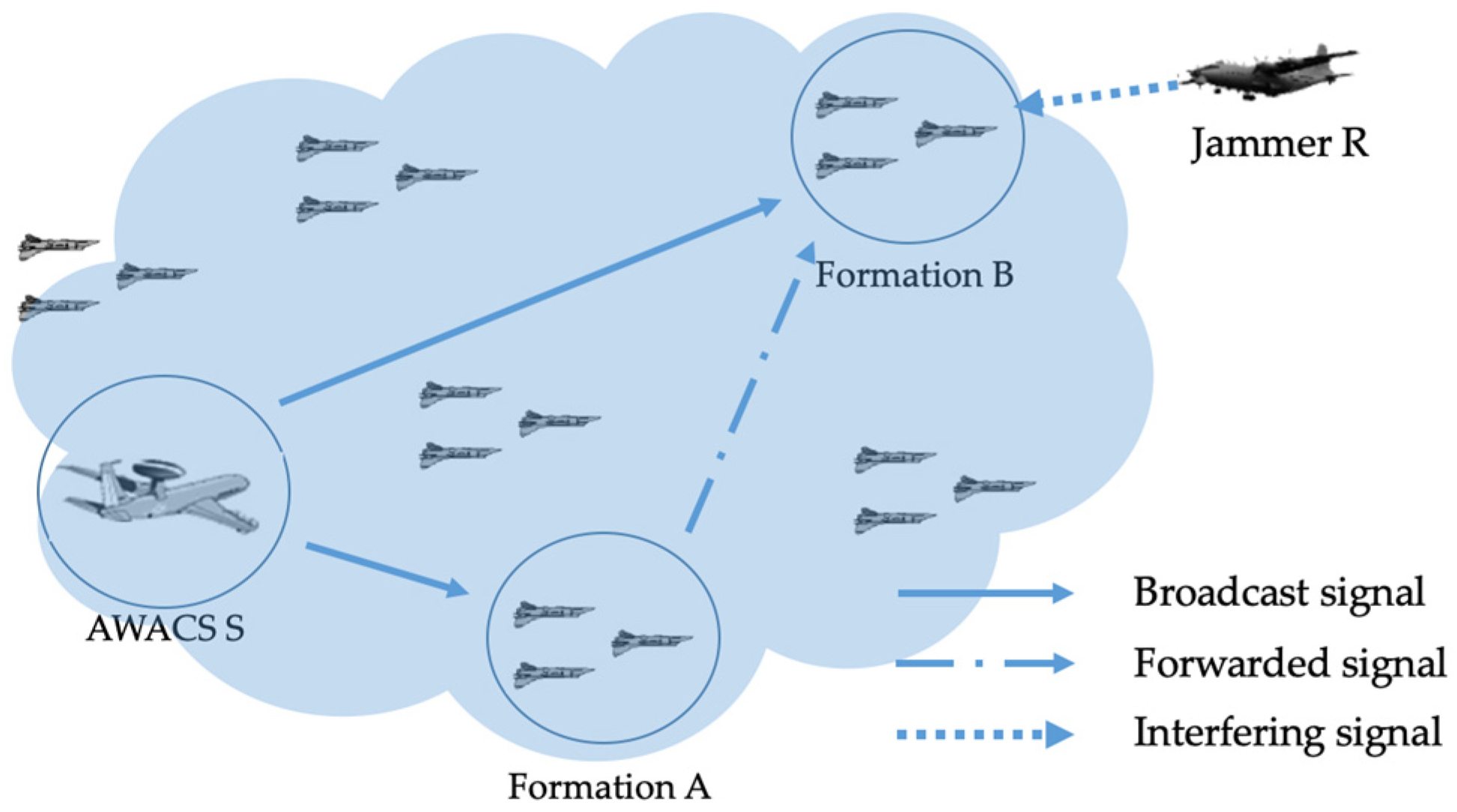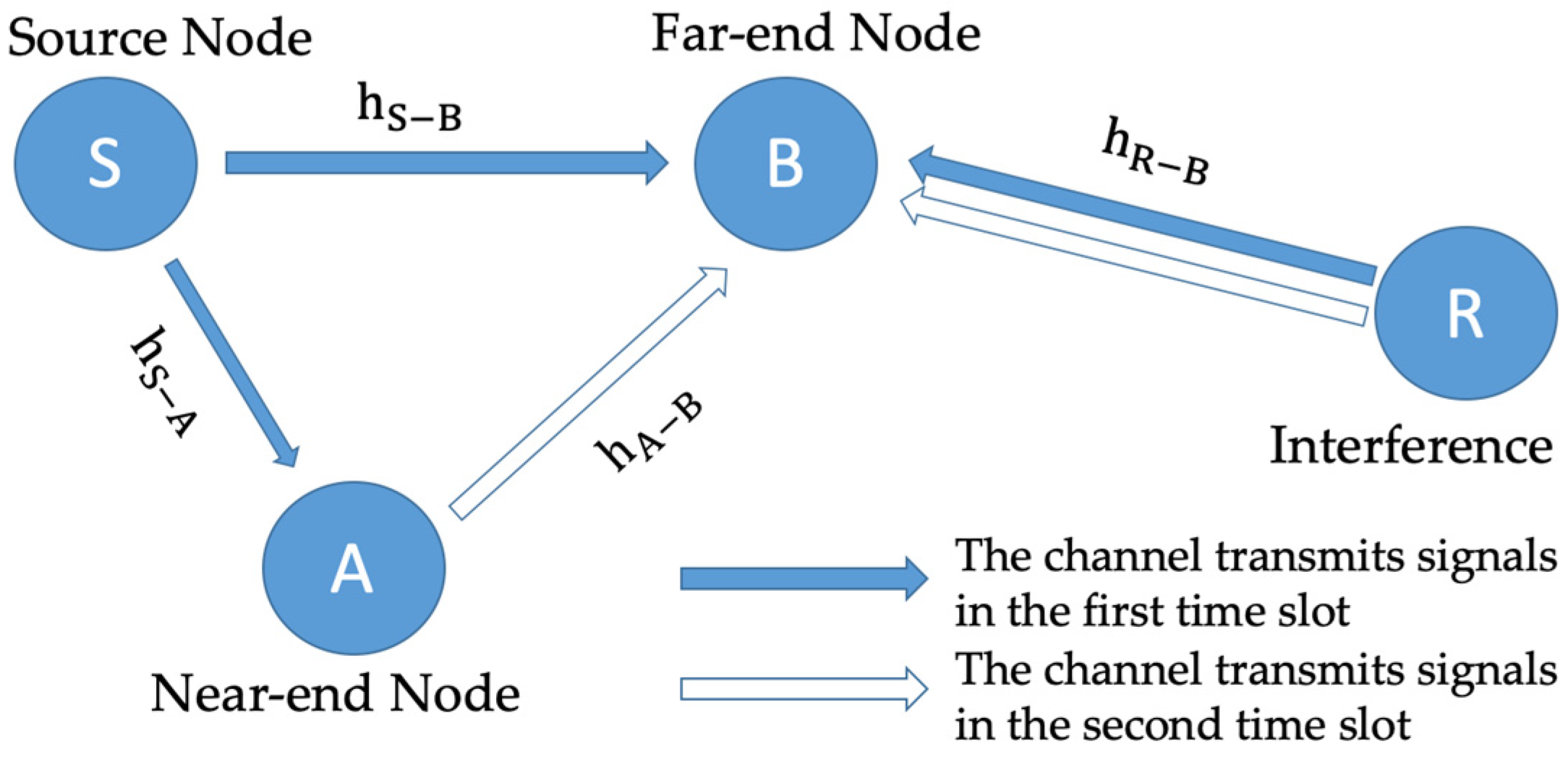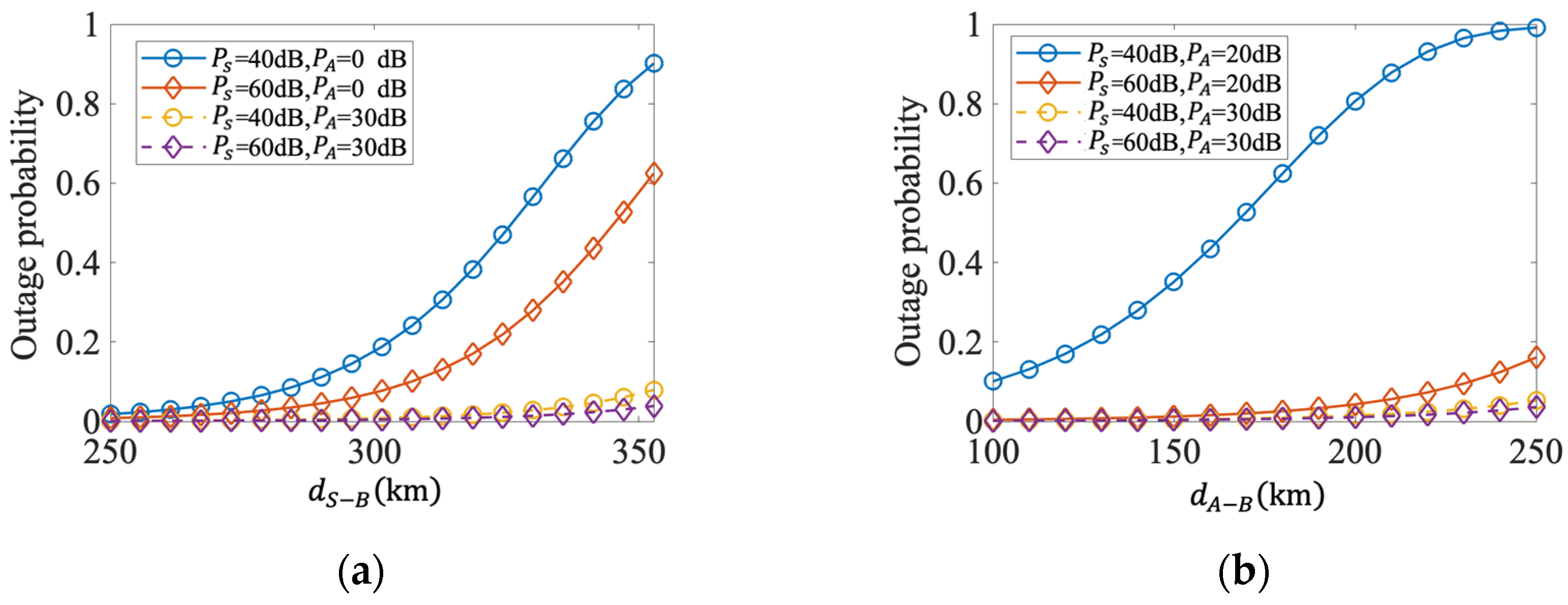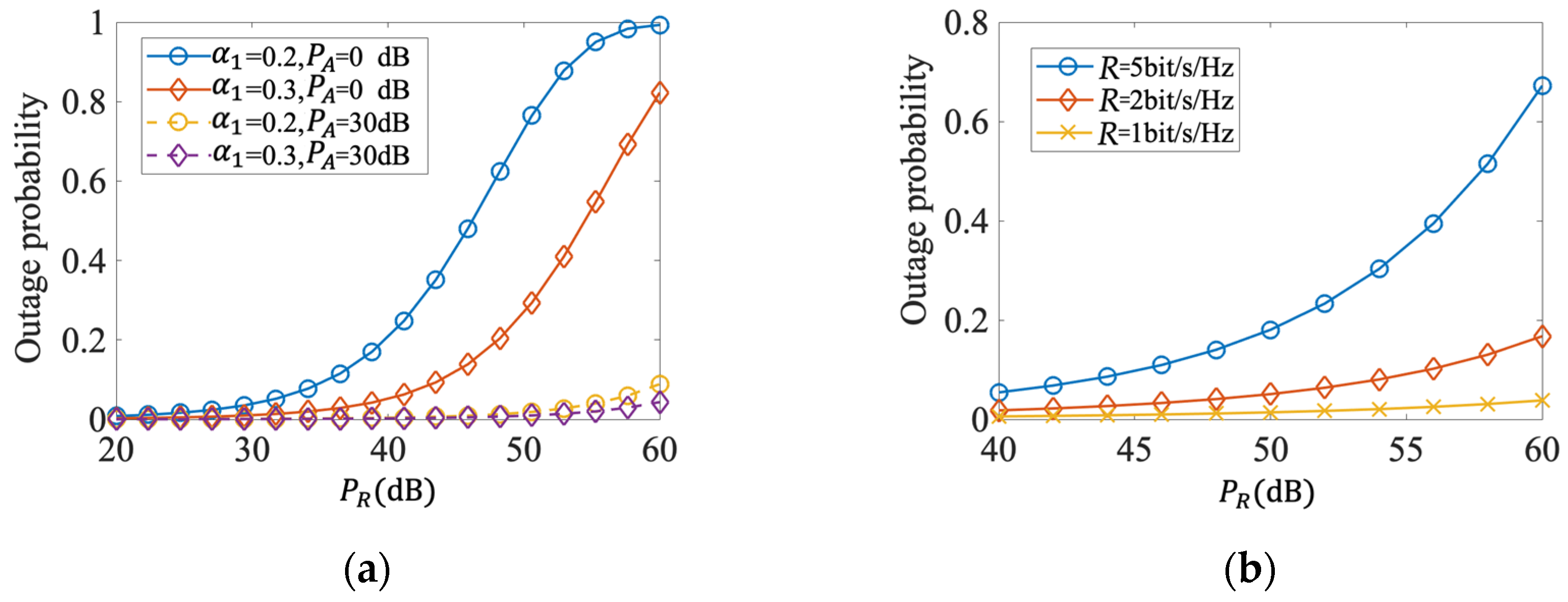Performance Analysis of Anti-Interference Cooperative NOMA System for Aviation Data Links
Abstract
:1. Introduction
2. System Model
2.1. Scenario Assumptions
2.2. The Anti-Interference Cooperative NOMA System Model for Aviation Data Links
2.2.1. Description of the Cooperative Process
2.2.2. Channel Capacity
3. Outage Probability
- (1)
- At node A.
- (2)
- At node B.
4. Numerical and Simulation Results
4.1. Transmit Power and Relay Power
4.2. Transmission Distance
4.3. Interference Signal Power
4.4. Data Transmission Rate
5. Conclusions
Author Contributions
Funding
Data Availability Statement
Conflicts of Interest
References
- Cheng, B.-N.; Wang, X.-H.; Liu, Y.; Liu, F.; Zhang, T.-Y. Design Considerations for Next-Generation Airborne Tactical Networks. IEEE Commun. Mag. 2014, 52, 138–145. [Google Scholar] [CrossRef]
- Stoica, A.; Militaru, D.; Moldoveanu, D.; Popa, A. Tactical Data Link—From Link-1 to Link-22. Sci. Bull. Mircea Cel Batran Naval Acad 2016, 19, 346. [Google Scholar]
- Sorroche, J.; Byers, R.; Barrett, N. Tactical Digital Information Link-Technical Advice and Lexicon for Enabling Simulation (Tadil-tales) Ii: Link 11/11b. Asrc Communication Ltd Kirtland Afb Nm Distributed Mission Operations Center. Tech. Rep. 200. Available online: https://books.google.com.hk/books/about/Tactical_Digital_Information_Link_Techni.html?id=i19mnQAACAAJ&redir_esc=y (accessed on 1 June 2005).
- Yilmaz, A.E.; Ozel, R.M.; Ilk, H.G. Analysis and Modeling of Multiple Tactical Data Links. In Proceedings of the IEEE 12th Signal Processing and Communications Applications Conference, Kusadasi, Turkey, 30 April 2004; pp. 763–766. [Google Scholar] [CrossRef]
- Hoekstra, W.E. Tactical Data Links and Interoperability, the Glue between Systems; Nato Consultation Command and Control Agency: Hague, The Netherlands, 2001. [Google Scholar]
- Bal, A.; Tajwar, R. Execution of Hybrid NOMA Schemes Concerning Outage Performance and Sum Rate Interplay. Appl. Sci. 2021, 11, 4967. [Google Scholar] [CrossRef]
- Reddy, P.V.; Kumar, M.A.; Krishna, G.M. Analytical Review on OMA vs. NOMA and Challenges Implementing NOMA. In Proceedings of the 2nd International Conference on Smart Electronics and Communication (ICOSEC), Trichy, India, 20–22 October 2022; pp. 552–556. [Google Scholar]
- Ding, Z.; Lei, X.; Karagiannidis, G.K.; Schober, R.; Yuan, J.; Bhargava, V.K. A Survey on Non-Orthogonal Multiple Access for 5G Networks: Research Challenges and Future Trends. IEEE J. Sel. Areas Commun. 2017, 35, 2181–2195. [Google Scholar] [CrossRef]
- Zeng, J.; Zhao, B.; Zhang, Z.; Liu, C.; Hu, R.Q. Investigation on Evolving Single-Carrier NOMA into Multi-Carrier NOMA in 5G. IEEE Access 2018, 6, 48268–48288. [Google Scholar] [CrossRef]
- Yadav, A.; Quan, C.; Varshney, P.K.; Poor, H.V. On Performance Comparison of Multi-Antenna HD-NOMA, SCMA, and PD-NOMA Schemes. IEEE Wirel. Commun. Lett. 2021, 10, 715–719. [Google Scholar] [CrossRef]
- Maraqa, O.; Rajasekaran, A.S.; Al-Ahmadi, S.; Yanikomeroglu, H.; Sait, S.M. A Survey of Rate-Optimal Power Domain NOMA With Enabling Technologies of Future Wireless Networks. IEEE Commun. Surv. Tutor. 2020, 22, 2192–2235. [Google Scholar] [CrossRef]
- Khan, W.U.; Jamshed, M.A.; Lagunas, E.; Chatzinotas, S.; Li, X.; Ottersten, B. Energy Efficiency Optimization for Backscatter Enhanced NOMA Cooperative V2X Communications under Imperfect CSI. IEEE Trans. Intell. Transp. Syst. 2022, 1–12. [Google Scholar] [CrossRef]
- Alkama, D.; Zenadji, S.; Ouamri, M.A.; Khireddine, A.; Azni, M. Performance of Resource Allocation for Downlink Non-Orthogonal Multiple Access Systems in Tri-Sectorial Cell. In Proceedings of the 2022 IEEE International Conference on Electrical Sciences and Technologies in Maghreb (CISTEM), Tunis, Tunisia, 26–29 October 2022; pp. 1–6. [Google Scholar] [CrossRef]
- Prashar, A.; Sood, N. Performance Analysis of MIMO-NOMA and SISO-NOMA in Downlink Communication Systems. In Proceedings of the 2nd International Conference on Intelligent Technologies (CONIT), Hubli, India, 24–26 June 2022; pp. 1–5. [Google Scholar] [CrossRef]
- Kaur, J.; Singh, M.L. User Assisted Cooperative Relaying in Beamspace Massive MIMO NOMA Based Systems for Millimeter Wave Communications. China Commun. 2019, 16, 103–113. [Google Scholar] [CrossRef]
- Auyo, A.M.; Babale, S.A.; Bello, L.M. Effect of Inspired CR-NOMA Power Allocation on Bit Error Rate for Three User NOMA System. In Proceedings of the 2022 IEEE Nigeria 4th International Conference on Disruptive Technologies for Sustainable Development (NIGERCON), Lagos, Nigeria, 5–7 April 2022; pp. 1–5. [Google Scholar] [CrossRef]
- Durceylan, M.N.; Gemici, Ö.F.; Özdemir, G.; Hökelek, İ.; Çırpan, H.A. Fuzzy Logic Based Power Allocation for Cooperative NOMA Systems. In Proceedings of the 2022 International Balkan Conference on Communications and Networking (BalkanCom), Sarajevo, Bosnia and Herzegovina, 22–24 August 2022; pp. 11–15. [Google Scholar] [CrossRef]
- Iswarya, N.; Jayashree, L.S. A Survey on Successive Interference Cancellation Schemes in Non-Orthogonal Multiple Access for Future Radio Access. Wirel. Pers. Commun. 2021, 120, 1057–1078. [Google Scholar] [CrossRef]
- Ding, Z.; Yang, Z.; Fan, P.; Poor, H.V. On the Performance of Non-Orthogonal Multiple Access in 5G Systems with Randomly Deployed Users. IEEE Signal Process. Lett. 2014, 21, 1501–1505. [Google Scholar] [CrossRef]
- Gupta, P.; Ghosh, D. User Fairness based Energy Efficient Power Allocation for Downlink Cellular NOMA System. In Proceedings of the 2020 5th International Conference on Computing, Communication and Security (ICCCS), Patna, India, 14–16 October 2020; pp. 1–5. [Google Scholar]
- Chen, J.; Yang, L.; Alouini, M.-S. Physical Layer Security for Cooperative NOMA Systems. IEEE Trans. Veh. Technol. 2018, 67, 4645–4649. [Google Scholar] [CrossRef]
- Bal, A.; Khan, M.R.H.; Peyal, M.K. Performance Comparison among Hybrid NOMA Schemes Focusing on Outage Performance and Sum Rate Arrangement. In Proceedings of the 2021 2nd International Conference for Emerging Technology (INCET), Belagavi, India, 21–23 May 2021; pp. 1–5. [Google Scholar] [CrossRef]
- Ding, Z.; Peng, M.; Poor, H.V. Cooperative Non-Orthogonal Multiple Access in 5G Systems. IEEE Commun. Lett. 2015, 19, 1462–1465. [Google Scholar] [CrossRef]
- Guo, S.; Xiaolin, X.; Bao, T.; Yuguang, F. Research Progress of Anti-jamming Technology of Unmanned Aerial Vehicle (UAV) Data Link. IOP Conf. Ser. Mater. Sci. Eng. 2020, 816, 012011. [Google Scholar] [CrossRef]
- Li, C.; Qi, P.; Wang, D.; Li, Z. On the Anti-Interference Tolerance of Cognitive Frequency Hopping Communication Systems. IEEE Trans. Reliab. 2020, 69, 1453–1464. [Google Scholar] [CrossRef]
- Suryana, J.; Candra, D. Implementation of Link-16 based Tactical Data Link System Using Software-Defined Radio. In Proceedings of the 2019 International Conference on Electrical Engineering and Informatics (ICEEI), Bandung, Indonesia, 9–10 July 2019; pp. 555–559. [Google Scholar]
- Qi, N.; Zhang, Q.; Liu, R.P.; Huang, J.; Leung, V.C.M. A Learning-Based Spectrum Access Stackelberg Game: Friendly Jammer-Assisted Communication Confrontation. IEEE Trans. Veh. Technol. 2021, 70, 700–713. [Google Scholar] [CrossRef]
- Yu, F.; Na, L.; Kun, C. Performance Analysis of Data Link System Based on NOMA Technology under Interference Conditions. J. Signal Process. 2020, 36, 1029–1037. [Google Scholar]
- Elsaraf, Z.; Ahmed, A.; Khan, F.A.; Ahmed, Q.Z. Non-orthogonal multiple access for wireless communication networks by exploiting the EXIT chart analysis. EURASIP J. Wirel. Commun. Netw. 2021, 2021, 79. [Google Scholar] [CrossRef]






| Parameters | Value |
|---|---|
| Transmit power of the AWACS | 40 dB |
| Relay power of aircraft formation A | 30 dB |
| Enemy jamming power | 50 dB |
| Power allocation coefficient | 0.3 |
| Transmission distance | 200 km |
| Transmission distance | 300 km |
| Transmission distance | 250 km |
| Transmission distance | 200 km |
| Rice factor | 10 dB |
| Rice factor | 15 dB |
| Rice factor | 12.5 dB |
| Rice factor | 10 dB |
| Data transmission rate R | 1 bit/s |
Disclaimer/Publisher’s Note: The statements, opinions and data contained in all publications are solely those of the individual author(s) and contributor(s) and not of MDPI and/or the editor(s). MDPI and/or the editor(s) disclaim responsibility for any injury to people or property resulting from any ideas, methods, instructions or products referred to in the content. |
© 2023 by the authors. Licensee MDPI, Basel, Switzerland. This article is an open access article distributed under the terms and conditions of the Creative Commons Attribution (CC BY) license (https://creativecommons.org/licenses/by/4.0/).
Share and Cite
Zhang, X.; Lv, N. Performance Analysis of Anti-Interference Cooperative NOMA System for Aviation Data Links. Electronics 2023, 12, 2182. https://doi.org/10.3390/electronics12102182
Zhang X, Lv N. Performance Analysis of Anti-Interference Cooperative NOMA System for Aviation Data Links. Electronics. 2023; 12(10):2182. https://doi.org/10.3390/electronics12102182
Chicago/Turabian StyleZhang, Xuefeng, and Na Lv. 2023. "Performance Analysis of Anti-Interference Cooperative NOMA System for Aviation Data Links" Electronics 12, no. 10: 2182. https://doi.org/10.3390/electronics12102182





